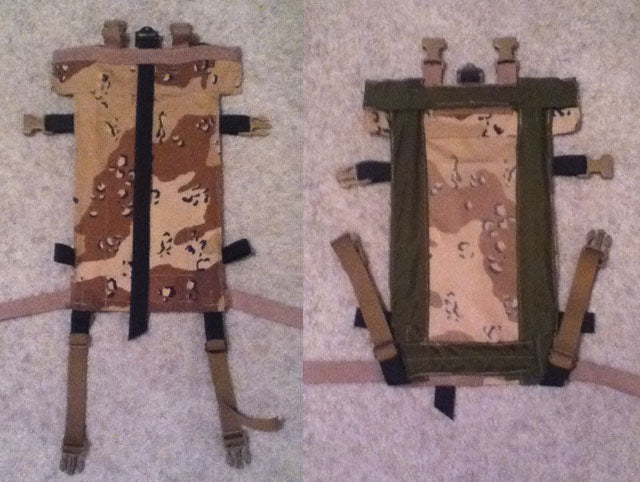The Development of the Oneiros Valley Load Lifter Panel

By Jesse Ables
The Beginning
The Load Lifter Panel (LLP) started its life at a coffee shop, in the early morning hours of September 2012, and was initially drawn out in MS Paint. As a NICE Frame user that's tall enough to not get an effective amount of shoulder strap lift, I wanted to develop an attachment that would raise the height of the frame's load lifters. This could be done one of two ways: Either by increasing the height of the load lifter buckles that connect to the shoulder straps or increasing the length of the frame. I dubbed the former the “Narrow Configuration” and the latter the “Wide Configuration.” Both would attach to the back of the NICE Frame, but the Narrow Configuration would protrude through the center of a rucksack's frame pocket, while the Wide Configuration would effectively increase the length of the frame and include attachment points for a rucksack’s compression and attachment straps. 
The Narrow Configuration LLP 
The Wide Configuration LLP. Note the longer upper horizontal stay and rucksack attachment points
Proof of Concept
Eighteen hours after I began drawing the idea out in MS Paint, I completed a proof of concept sample, constructed largely of spare fabric and pieces of scrap wood trim. The proof of concept was based on the initial Wide Configuration, with design improvements made during construction. Though a few issues were apparent, this example was reliable enough to warrant building a fully functional prototype.

LLP Proof of Concept
Prototype I
The first prototype was completed in early October. This example allowed the length of the NICE Frame to effectively be increased up to five inches. The carbon fiber stays were encased in 2” webbing, which allowed for weight savings over using two pieces of 1.5” webbing, but the webbing stretched when attached to the frame and put too much pressure on certain areas of stitching. This LLP featured a large upper panel stiffened with HDPE plastic and featured an attached Cordura nylon pocket which slipped over the top of the NICE Frame. When tested with a 100 pound rucksack, this sample caused the frame to bow backwards several inches, deforming the lumbar region of the frame. Because of this, the prototype was considered a failure.

LLP Prototype I. The lower stay webbing has not been sewn back in these photos
Prototype II
The second prototype, completed five days after the first, brought with it several notable design changes. This example had the vertical carbon fiber stays protruding 2” above the top of the upper horizontal stay, which afforded the same 5” load lifter height increase of the first prototype but only allowed the rucksack to be raised a maximum of 3”. Other changes included the removal of the rucksack compression and attachment strap points (as the lower maximum height negated their usefulness), a switch to 1.5” webbing over 2” for the stays, a carry handle and an improved frame attachment method. At the maximum height, this prototype also bowed the frame under a 100 pound load, prompting us to abandon trying to lengthen the frame and instead focus on increasing the height of the load lifters (the “Narrow Configuration”).

LLP Prototype II
Prototype III
The first narrow configuration prototype solved most of the shortcomings of the previous samples and weighed in at only 9.4 ounces, a drastic reduction from the nearly one pound weight of the second prototype. In addition, the design reduced the total materials used (eliminating the HDPE sheet entirely) and increased manufacturing simplicity. This example was designed to attach to the frame's center two side release buckles instead of the outer two, allowing the frame to be used with a Load Sling.

LLP Prototype III
Prototype IV
The fourth prototype brought stability improvements and increased simplicity, and the LLP provided up to 6” of lift over the 5” of all previous examples. The Cordura nylon portion found on the third prototype was removed and an additional attachment strap was added. Overall weight: 10.1 ounces.

LLP Prototype IV
Mystery Ranch® and NICE® are registered trademarks of Mystery Ranch, Ltd.
